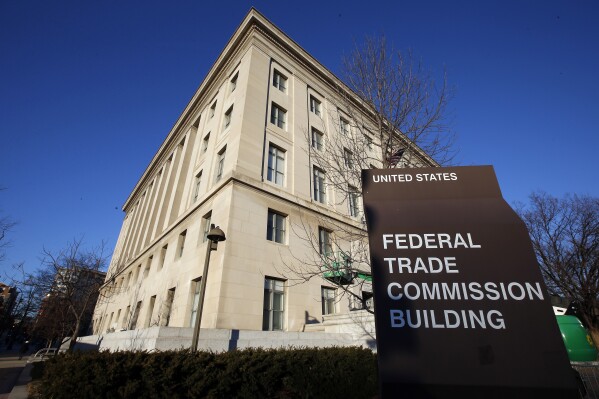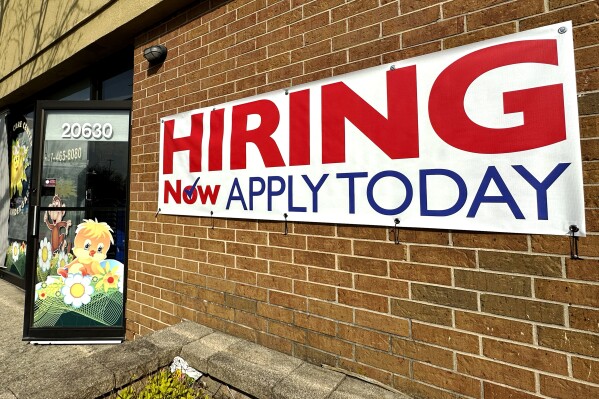How US changes to ‘noncompete’ agreements and overtime pay could affect workers

The Federal Trade Commission building is seen, Jan. 28, 2015, in Washington. U.S. companies would no longer be able to bar employees from taking jobs with competitors under a rule approved by the FTC on Tuesday, April 23, 2024, though the rule seems sure to be challenged in court. (AP Photo/Alex Brandon, File)

A hiring sign is displayed in Riverwoods, Ill., Tuesday, April 16, 2024. The Biden administration has finalized a new rule set to make millions of more salaried workers eligible for overtime pay in the U.S. The move marks the largest expansion in federal overtime eligibility seen in decades. (AP Photo/Nam Y. Huh, File)
BY CATHY BUSSEWITZ AND MAE ANDERSON
April 24, 2024
NEW YORK (AP) — For millions of American workers, the federal government took two actions this week that could bestow potentially far-reaching benefits.
In one move, the Federal Trade Commission voted to ban noncompete agreements, which bar millions of workers from leaving their employers to join a competitor or start a rival business for a specific period of time. The FTC’s move, which is already being challenged in court, would mean that such employees could apply for jobs they weren’t previously eligible to seek.
In a second move, the Biden administration finalized a rule that will make millions more salaried workers eligible for overtime pay. The rule significantly raises the salary level that workers could earn and still qualify for overtime.
The new rules don’t take effect immediately. And they won’t benefit everyone. So what exactly would these rules mean for America’s workers?
WHAT IS A NONCOMPETE AGREEMENT?
Noncompete agreements, which employers have deployed with greater frequency in recent years, limit an employee’s ability to jump ship for a rival company or start a competing business for a stated period of time. The idea is to prevent employees from taking a company’s trade secrets, job leads or sales relationships to a direct competitor, who could immediately capitalize on them.
Many industries use noncompete agreements, often among their salespeople, said Paul Lopez, managing partner at Tripp Scott, a Florida law firm that has handled more than 100 cases involving noncompete clauses.
“They’re the ones out there generating leads and sales,” Lopez said. “The last thing you as a business will want is for that person to go over to your competition and do the same thing.”
WHO IS TYPICALLY SUBJECT TO THESE AGREEMENTS?
People may assume that noncompete agreements apply only to high-level executives in the technology or finance industries. But many lower-level workers are subject to the restrictions as well. The rules vary by state.
In Florida, one medical sales worker was barred by his employer from joining a competitor for 10 years — and once he left his job, was unemployed for more than five years, said Stefanie Camfield, assistant general counsel with Engage PEO, a Florida company that handles human resources for small and medium-sized businesses.
“He was able to find another sales position in a completely different industry,” Camfield said. “But the learning curve was there, so he wasn’t making the same amount of money.”
In another case, a company in the optical industry that had hired a sales associate was informed by his former employer that it intended to enforce a noncompete agreement. So the optical company terminated the employee, Camfield said.
“They thought they had a qualified sales associate hired and ready to get to work, and all of a sudden now they’re back to square one.”
WHY BAN NONCOMPETE AGREEMENTS?
Some view noncompete agreements as harmful and unfair to workers by limiting their mobility. Career opportunities are often more attractive outside an employee’s current workplace. And with restrictions on the type of work they can do for a competitor, it can be hard to shift into a more suitable or lucrative position.
Many hiring managers, after all, most value job candidates who already have a certain level of experience in the same industry.
“A noncompete would unilaterally ban someone from getting exactly the kind of job that it’s reasonable to want,” said Jennifer Tosti-Kharas, a professor of organizational behavior at Babson College in Massachusetts. “To cut people off from that is overly paternalistic. It’s using a really blunt instrument to limit people’s mobility, when in reality there are other legal mechanisms to prevent trade secrets being disclosed.”
HOW DO I KNOW IF I’M SUBJECT TO A NONCOMPETE?
People are sometimes surprised to learn that they’re bound by such an agreement. They might not even find out until after they’ve left for a new job, and their former employer intervenes and causes them to be fired.
“When you join a company, you’re so focused on the opportunity in front of you, you might not be thinking about what’s that next jump,” Tosti-Kharas said.
Experts suggest that employees consult their human resources department about any noncompete agreements that might exist. If a workplace doesn’t have an HR department, an employee should ask a lawyer for the company.
ARE TRADE SECRETS NOW LIKELY TO BE SPILLED?
There are still laws on the books that protect companies’ trade secrets. The FTC decision doesn’t change that.
And the U.S. Chamber of Commerce has already filed a lawsuit against the Federal Trade Commission, calling its decision a dangerous precedent for government micromanagement of business. Lawsuits could delay any implementation of the FTC’s new rule, potentially for years.
WHAT ABOUT THE NEW OVERTIME RULES?
Starting July 1, employers of all sizes will be required pay overtime — time and a half salary after 40 hours a week — to salaried workers who make less than $43,888 a year in certain executive, administrative and professional roles. That cap will then rise to $58,656 by the start of 2025. Previously, the cap was $35,568.
WHO QUALIFIES?
The Labor Department estimates that 4 million salaried workers who weren’t previously eligible will qualify. Some occupations, though, including teachers, doctors and lawyers are not eligible for overtime pay and thus are not affected by the change. And some states, like California and New York, already have salary thresholds that exceed the federal level.
WHAT’S THE REACTION SO FAR?
Predictably, groups that represent companies have lined up against the new rule. Conversely, worker groups are applauding it as a necessary and long-overdue change.
The National Retail Federation argued that the new rules “curtail retailers’ ability to offer the most flexible, generous and tailored benefits packages to lower-level exempt employees across the industry.”
It also asserted that the new rules don’t give employers adequate time to make the changes needed. And it complained that the inclusion of automatic increases “exceeds the Department’s legal authority and oversteps longstanding Fair Labor Standards Act and Administrative Procedure Act principles.”
On the social media site X, the AFL-CIO labor organization said the rules will “restore and extend overtime protections for hard-working Americans.”
WILL THE CHANGES BE CHALLENGED IN COURT?
Almost certainly so. A 2016 effort by the Obama administration was scuttled in court just days before it was set to take effect. Because the new overtime rules won’t take effect until July 1, groups have time to study the ruling before mounting a challenge.
“I would expect there will be some legal challenges,” said Ted Hollis, a partner at the law firm Quarles & Brady. “When the Obama administration published its proposed rule in 2016, that was almost immediately challenged in court.”
HOW SHOULD BUSINESSES PREPARE FOR THIS?
Companies of all sizes will have to reclassify workers who will now qualify for overtime pay — and make sure they track hours and pay them properly.
Another option is to raise employees’ salaries so they would remain exempt from overtime. But employers should keep in mind that two more increases are coming under the new timetable.
They’ll also have to determine how they will budget for the extra pay for overtime. Small businesses will have the toughest time.
“Some are going to have to cut workers,” Hollis said. “Others will have to cut hours from existing workers.
“Some are going to have to raise prices, and some probably won’t be able to figure out a way to make it economically work and wind up having to shut down, unfortunately.”
MAE ANDERSON
New York-based reporter covering small business.

